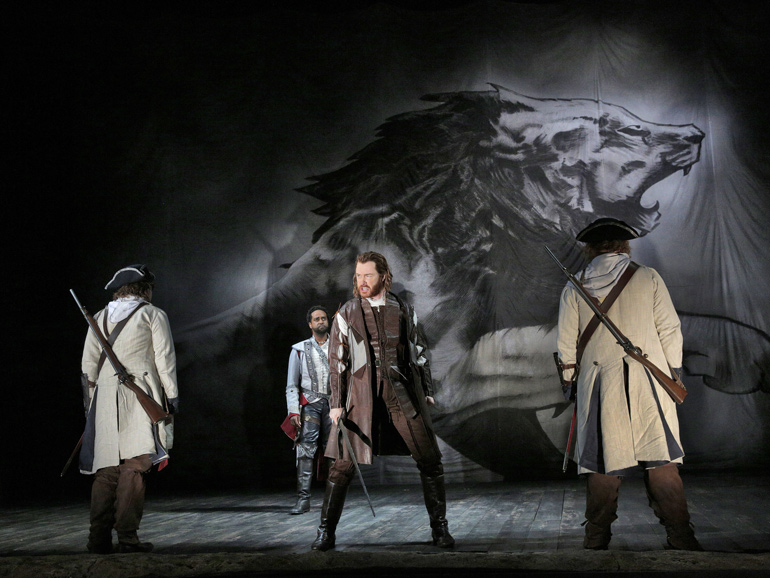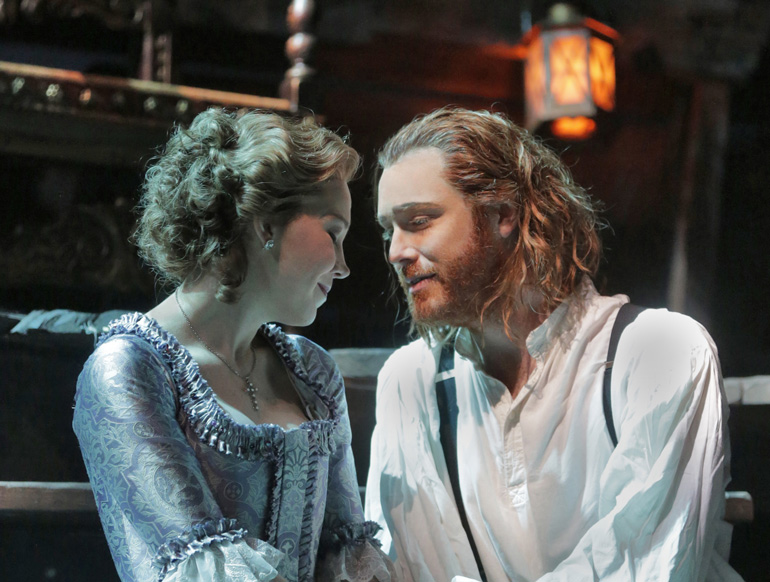
Handel’s Richard the Lionheart. Opera Theatre of St. Louis at Loretto-Hilton Theater. June 20, 2015.
St. Louis – I first visited Opera Theatre of Saint Louis (OTSL) in 2005 for a performance of Britten’s Gloriana, starring Christine Brewer. I was so impressed with the company and the venue that I have returned since, as often as I could. Never have I been disappointed. OTSL has truly found a niche for itself. While too many opera companies have gone bankrupt trying to match the Met with lavish productions and world-class singers, OTSL has kept to its modest budget without compromising artistic excellence. Performing in a small theatre, the company regularly presents world premieres and refreshing enactments of familiar fare. As of its 40th season, OTSL has presented 24 world and 24 American premieres.
This season was typical. There was no brand-new opera in 2015; instead, the OTSL programmed a revival of American composer Tobias Picker’s Emmeline, the American premiere of a new English version of Handel’s rarely performed Richard the Lionheart, a production of Puccini’s least-known opera La Rondine, and a fresh look at one of the most beloved of all operas, Rossini’s The Barber of Seville.
This year, although I only had time to attend a performance of the Handel opera, I came away amazed once more by the OTSL’s versatility. Handel’s opera Riccardo Primo was first produced in London (1726) by the composer’s own company, the Royal Academy of Music and sung in Italian. As the OTSL has a policy of producing operas in English, it commissioned a translation for the 2015 season; hence, Riccardo Primo became Richard the Lionheart.
Richard Coeur de Lion (1157-1199) was King of England for the last ten years of his life. Born in Oxford, he spent much of his life in France. There is some doubt as to whether he even spoke English. Richard, a man of action who enjoyed nothing more than a good battle, was a major player in the Third Crusade. The plot of Handel’s opera is loosely based on Richard’s shipwreck on Cyprus and his subsequent conquest of the island.

Susannah Biller as Costanza and Tim Mead as Richard the Lionheart in Opera Theatre of Saint Louis’s 2015 production of Richard the Lionheart (Photo: Ken Howard)
Although this was not a period instrument performance, members of the St. Louis Symphony sounded very much at home with conductor Grant Llewellyn’s historically informed approach. Lee Blakeley’s staging also appeared to be historically accurate. And what a cast! Countertenor Tim Mead, making his OTSL debut in the role of Richard, was sensational. His mastery of Handel’s ornamentation was remarkable, and the sheer beauty of his voice stopped the show on several occasions. Soprano Susannah Biller was no less superlative as Costanza. The duet between Richard and Costanza – the only duet in the opera – was without a doubt the highlight of the evening as their voices blended perfectly together.
Costanza’s ‘mad scene’ also captivated the audience. Biller once again sang with remarkable beauty and control and the obbligato sopranino recorder part was played with stunning virtuosity by Laura Osterlund.
Overall, the cast, conductor and director deserve enormous credit for making sense of what often appears to be an archaic musical style. In this performance of Richard the Lionheart, I was struck by how often the vocal ornamentation, so often dismissed as mere decoration, came across as enhancement of the emotions being expressed by the singer.
My only disappointment, as far as the orchestra was concerned, was the battle scene. Trumpets and drums that should get to strut their stuff here, were too far back in the pit – practically under the stage – to have much impact. Surely Handel wanted some really robust playing to accompany this scene.
Director Lee Blakely appeared to be using stage devices similar to those available in Handel’s time, and giving us a rendition of the story consistent with the original performances; without further scholarly inquiry, however, one cannot be certain of this. A case in point is the aforementioned “mad scene.” The text alone contains nothing to suggest that Costanza has gone mad, and there is nothing in the opera foreshadowing this madness. Did Handel and his librettist Paolo Antonio Rolli write a mad scene, or is this Blakeley’s invention? I have no idea, but as a set piece it worked very effectively as a depiction of Costanza’s retreat into unreality in the face of her trials, and as such, added another dimension to her characterization.
Similar questions arise with respect to the last scene of the opera. On the face of it, Handel and his collaborators wrote a happy ending with goodness triumphing over evil. There is no doubt about what Handel intended in this instance because when he revised the work shortly after its premiere, his revisions were clearly intended to celebrate the patriotism of King George II who had just ascended to the throne. Given this context, King Richard in the opera is portrayed as a wise and just English monarch by Handel, whereas in Lee Blakeley’s St. Louis production this portrayal is deliberately undermined in the last scene by having the bodies of dead soldiers in cages slowly drop from the “flies” and remain hanging in plain sight as the opera comes to an end. To underscore the significance of this moment, Richard’s associates on stage look at this tableau in horror.
My guess is that Blakely decided Handel’s 1727 revisions to honour King George need not be perpetuated today, and chose instead to give us a more honest assessment of Richard the Lionheart, who, while celebrated for his military exploits, was also said to be “vicious” in his treatment of adversaries.
Handel’s original opera was written, in part, as a showcase for two of the foremost sopranos of the day: Francesca Cuzzoni and Faustina Bordoni. The role of Richard the Lionheart was designed for an even bigger star, castrato Francesco Bernadi, known as “Senesino.”
It is difficult to imagine that “Senesino” could have been any more impressive than countertenor Tim Mead in this OTSL production. OTSL’s Susannah Biller as Costanza and Devon Guthrie as Pulcheria, were also first-rate.
Choosing a little-known but significant opera, OTSL gave it a production that would be a triumph at any opera house in the world.
Opera Theatre of St. Louis has excelled yet again.
#LUDWIGVAN
Want more updates on Toronto-centric classical music news and review before anyone else finds out? Get our exclusive newsletter here and follow us on Facebook for all the latest.
- SCRUTINY | TSO Lets Berlioz Do The Talking In Season Opener - September 21, 2018
- RECORD KEEPING | Even Yannick Nézet-Séguin Can’t Make Us Love Mozart’s La Clemenza di Tito - September 6, 2018
- RECORD KEEPING | Giovanna d’Arco With Anna Netrebko Explains Why The Best Operas Survive - August 30, 2018



